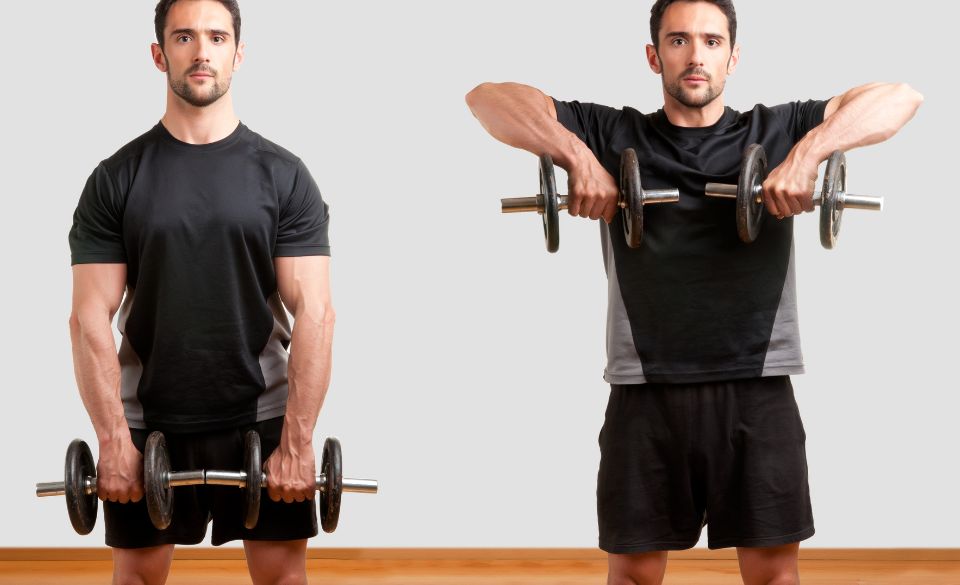
Strengthen Your Deltoids With Posterior, Anterior & Unilateral Exercises
Page Contents
Developing strong, toned deltoid muscles is an important step towards a sculpted, physique. Posterior exercises can be an extremely effective means of strengthening the deltoids. Although this may be daunting at first, there are simple exercises that can help achieve fantastic results. By following a few basic principles of training and including posterior exercises as part of your fitness routine, you can give your deltoid muscles the attention they need.
To begin, it’s essential to understand the basics of the deltoids anatomy. This muscle is divided into three parts – the anterior, lateral, and posterior. Each of these sections helps to stabilize the shoulder joint and is responsible for a range of dynamic movements. The posterior deltoid is largely responsible for shoulder extensions and is therefore essential when it comes to strengthening the deltoids.
To strengthen the posterior deltoids, nothing beats incorporating posterior exercises into your routine. Common posterior exercises include the high pulley cable row, cable lateral raise, reverse flies, bent over lateral raise, and face pulls. It’s important to understand the basics of how each exercise works and how it’s specifically targeting the posterior deltoids. Working out how to safely and effectively use each one is key.
With this in mind, the key to effective training lies in good form and proper technique. Rather than just going through the motions, ensure you’re really engaging the right muscles. Focus on the mind-muscle connection by paying attention to how it feels in each part of the movement. This will help to get the most out of every exercise and ensure muscles are being activated properly.
When it comes to deltoid posterior exercises, it’s important to focus on compound movements. Think about the ways each exercise prepares you for movements in everyday life. It is also vital to keep rest between training sets in mind. Ensuring enough rest in between sets helps the targeted muscles to recover and prepares you for the next exercise.
In order to maximize the effectiveness of your posterior deltoid exercises, it’s also important to consider the following:
Level of Intensity :
The intensity of each exercise should take into account both the weight and the complexity of the movements. Heavier weights will help to target the intended muscles but it’s important not to overload on too much weight if mobility isn’t at the required level.
Amount of Resistance:
The right amount of resistance is key to developing the posterior deltoid muscles. Check that the amount of resistance is suitable and always ensure you’re challenging yourself.
Number of Reps and Sets:
The number of reps and sets you perform for each exercise should vary depending on your level of experience. If you’re a beginner, stick to lower reps and higher sets and increase the weight gradually.
Range of Movement:
Finally, focus on understanding the desired range of each exercise. By stretching the muscles correctly and performing each motion as far as mobility allows, you should get the best out of each training session.
Incorporating posterior exercises into your daily routine is a great way to develop stronger deltoids. However, ensure you keep in mind the key points mentioned above, ranging from intensity and resistance to range of motion. With enough dedication and the right level of expertise, you’re sure to see fantastic results in no time.
Strengthening Your Deltoid With Anterior Exercises
Developing strong, toned deltoid muscles is an integral part of creating a healthy, well-defined physique. Anterior exercises are an effective way to bolster the deltoids muscle and promote toning. Although this can seem like a daunting task at first, the addition of a few simple exercises to your routine can help achieve incredible results. By understanding the basics of deltoid anatomy and following a few essential training principles, you can improve your deltoid muscles today.
It all begins with understanding the anatomy of the deltoid. This muscle is divided into three parts – the anterior, lateral, and posterior. Each part supports the shoulder joint and is responsible for a range of complex movements. The anterior deltoid is largely responsible for shoulder abduction and abduction of the arm. This means that targeting the anterior deltoids is necessary if your goal is to strengthen all the deltoids muscle.
Incorporating a few anterior exercises into your routine is a simple way to achieve your desired results. Common anterior exercises include the dumbbell front raise, the shoulder press, and the upright row. Each of these exercises targets the anterior deltoid muscles and can be set up in the comfort of your own home. That being said, knowledge of the correct form and technique is necessary to achieve the best results.
The article to this point has highlighted the importance of form and technique when it comes to maximizing the effectiveness of any exercise. To this end, familiarizing yourself with the details of each exercise is key to success. Moreover, it’s important to ensure your muscles are fully engaged throughout the set. Concentrating on the mind-muscle connection really helps to achieve this and can be extremely beneficial to your training.
Furthermore, the range of motion of each exercise is essential. Making sure you’re stretching the muscles correctly is crucial to their development. Aiming for a moderate level of tension is also beneficial and prevents the movements from becoming too labored.
When it comes to optimizing the effectiveness of anterior deltoid exercises, it’s worth considering some concepts. These include, but are not limited to, intensity, reps and sets, and resistance. With these in mind, consider your own level of experience and what limitations the exercise may have due to poor form or incorrect technique.
Overall, including a few targeted deltoid anterior exercises in your routine can be extremely helpful in achieving strong, toned muscles. To start seeing the results you’re looking for, incorporate these key points into your program. Remember to focus on using good form and technique, paying attention to spelling out the muscles being used.
Finally, be Prepared to challenge yourself. Don’t be afraid to vary your levels of intensity and push yourself to progressively higher heights. With the right commitment and effort, you’re sure to see fantastic results in your deltoid muscles in no time.
Strengthening Your Deltoid With Unilateral Exercises
Building strength and toning the deltoids can be a difficult task yet is incredibly rewarding. Unilateral exercises can be an outstanding way to target all three parts of the deltoid muscle. Although this may be daunting at first, the incorporation of a few basic exercises into your routine can help to achieve spectacular results. Read on to gain an understanding of the basics of unilateral exercises and how they can help strengthen the deltoids.
Firstly, it’s important to understand the anatomy of the deltoids. This muscle is divided into three parts: the anterior, lateral, and posterior. Each section plays a role in stabilizing the shoulder joint and managing dynamic movements. Unilateral exercises can help target each of these sections and are great at getting the most out of every workout.
To get the most out of your deltoid workout, incorporate a few unilateral exercises. Common unilateral exercises include the lateral raise, bent laterals, and wide row. As always, it’s important to understand the fundamentals of each exercise. Additionally, it’s crucial to fully engage the mind-muscle connection as it helps bring balance to the movements.
Having solid form and proper technique is a must when performing any unilateral exercise. Ensure every rep is performed in a safe and controlled manner. First, make sure you feel each rep slowly. Secondly, focus on feeling the intended muscle being worked. As with any exercise, keeping the tension on the muscle throughout the entire exercise gets the best results.
When it comes to unilateral exercises, the aim is to get the most out of each workout. Many variables come into play in order to ensure this happens. These include level of intensity, amount of resistance, number of reps and sets, and the range of movement. As such, it’s important to take these into consideration when performing each exercise.
Finally, remember that it’s very easy to fall into complacency with any exercise, especially unilateral exercises. Ensure you continue to push yourself and keep the intensity at optimum levels. Consider progressing with additional weights or varying the range of motion. With enough hard work and dedication, you’re sure to see great results.
Unilateral exercises can be a great way to target the deltoids muscle and bring it the attention it deserves. Developing a routine with the right exercises is only part of the puzzle. In order to make the most out of every session, make sure to keep in mind the important details mentioned above. Aim for that optimal level of intensity and ensure you’re paying attention to the mind-muscle connection. With all these steps in place, you should start noticing improvements in no time.
Strengthening Your Deltoid With Post Activation Potentiation Exercises
For many, developing strong and toned deltoid muscles can be a daunting challenge. However, post activation potentiation exercises are incredibly effective when it comes to strengthening the deltoid muscles. Although it can be difficult to know where to start, we can provide a few common exercises that focus on post activation potentiation. Read on to learn how to incorporate PAP exercises into your training regime and get a strong deltoid workout.
To begin, let’s take a look at the anatomy of the deltoid. This muscle is split into three parts – the anterior, lateral, and posterior. Each section is responsible for stabilizing the shoulder joint and managing dynamic movements. Post activation potentiation exercises are an effective way of strengthening all these parts and getting the most out of your workout.
By adding a few post activation potentiation (PAP) exercises into your routine, you can have a significant impact on how well the deltoid muscle develops. Common PAP exercises include the upright row, weighted lateral raise, and weighted front raise. In addition to understanding the anatomy of the deltoids, it’s important to understand the basics of how each exercise works and how it’s specifically targeting the muscle.
Having sufficient form and technique is essential to ensure you get the most out of your workout. Being familiar with the details of each exercise is crucial to successful stretching of the deltoids muscle. Equally as important, it’s essential to pay attention to the mind-muscle connection ensuring you’re really engaging the muscles.
To maximize the efficiency of your post activation potentiation exercises, bear in mind the following points:
Level of Intensity:
The intensity should consider the weight being used and the complexity of the movements. Gradually incorporating heavier weights is helpful as long as your form and technique are spot on.
Amount of Resistance:
The amount of resistance should be appropriate for your experience level and for your target poses. This will ensure muscles are working effectively with the least risk of injury.
Number of Reps and Sets:
The number of reps and sets will vary depending on your experience level. Beginners should focus on higher sets and lower reps, gradually increasing the weight and reps over time.
Range of Movement:
Focus on understanding the desired range of each exercise. This should be done slowly and it’s important to take into account the specific mobility requirements of each exercise.
Post activation potentiation (PAP) exercises can have significant benefits when targeting the deltoids muscle. Make sure to incorporate the details mentioned above into your routine and challenge yourself to progressively higher heights. Remember to always focus on using good form and proper technique – paying attention to the mind-muscle connection is key. With the right level of commitment and dedicaion, you’ll begin to see outstanding results in no time.
Strengthening Your Deltoid With Speed Based Exercises
Speed-based exercises are a fantastic way to strengthen and develop the deltoid muscle. This helps to create a toned physique with impressive body control as well as fantastic muscular strength. Although this can be daunting at first, with the right exercises, perfect form, and expert technique, speed exercises can have incredible results. Here, we’ll take a look at exactly how these exercises can help supercharge your deltoid workout.
Before we delve into the perfect speed exercises, let’s start with the basics of deltoid anatomy. This muscle is divided into three parts: the anterior, lateral, and posterior. Each of these parts plays a role in stabilizing the shoulder joint and managing both static and dynamic exercises. Speed based exercises help to target all three sections of the deltoids muscle.
By incorporating a few simple speed exercises into your routine, you’ll be able to target your like never before. Common speed exercises include push press, medicine ball slams, barbell snatch, and jumping pull ups. It’s important to understand the fundamentals of how each exercise works and how it’s particular targeting the deltoids. Additionally, note that form and technique are essential for success with these exercises.
In addition, understanding the mind-muscle connection is key in maximising the effectiveness of any exercise. When it comes to speed exercises, focusing on the movement and feeling the correct muscles being targeted can help get the most out of each set.




